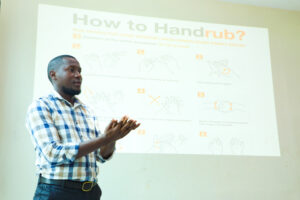Designing and Implementing a Continuous Quality Improvement Approach to Advance Infection Prevention and Control in Uganda
By Hassan Kasujja, Technical Advisor, MTaPS Program
The Medicines, Technologies, and Pharmaceutical Services (MTaPS) Program funded by the US Agency for International Development (USAID) has been supporting Uganda since 2019 to improve its practices and structures for infection prevention and control (IPC). The MTaPS-supported baseline assessment of IPC capacity and practices at national level and at select health care facilities (HCFs) showed that over 15% of admitted patients contracted health care-associated infections (HCAIs), with rates reaching as high as 30% in some HCFs. This resulted in poor treatment outcomes, prolonged hospital stays, and increased health care costs. Although the World Health Organization (WHO) recommends hand hygiene as a key intervention to reduce HCAIs, compliance with that intervention was low in Uganda. Adherence to the WHO five moments for hand hygiene averaged 22% nationally and was below 10% in some HCFs, according to the same baseline report.
MTaPS adapted the WHO multimodal improvement strategy and utilized Continuous Quality Improvement (CQI) techniques to enhance IPC in 13 selected HCFs, focusing on hand hygiene as the entry point. Six of the HCFs, which were selected based on available resources and a demonstrate high level of interest, received intensified targeted support to implement IPC interventions with the goal of establishing those facilities as centers of excellence for IPC.

Hassan Kasujja demonstrates proper handrubbing technique during IPC training. Photo Credit: JP Waswa STA MTaPS.
Setting up
When implementing the approach in the HCFs, MTaPS, together with the Ministry of Health, first directly engaged with facility administrators to secure buy-in. They presented a compelling business case, highlighting how improved IPC practices would reduce HCAIs and subsequently save the facility money through shortened patient hospital stays and reduced operational costs and workload. This was followed by the revitalization, strengthening, and/or establishment of IPC committees to oversee the program and the establishment of IPC teams of 4–5 people to conduct daily tasks under the committees’ supervision. The process began with drafting terms of reference that were then approved by the facility administration, after which commitment letters acknowledging the committees’ existence and pledging support were obtained from HCF administrators. Representatives from key hospital wards and departments were co-opted onto the committees, and leadership was selected in accordance with national guidelines, with modifications where necessary.
Prioritizing interventions
MTaPS supported baseline assessments of health care facilities and health care workers using WHO standard tools, including the Infection Prevention and Control Assessment Framework (IPCAF) to assess IPC capacity; the Hand Hygiene Self-Assessment Framework (HHSAF) to assess hand hygiene capacity; the Observation Tool to assess compliance with hand hygiene procedures; and the Hand Hygiene Knowledge Questionnaire to assess knowledge on hand hygiene and HCAIs. Based on these assessments, six-month CQI plans were developed through an eight-step process comprising:
- mapping stakeholders for hospital IPC program implementation
- identifying problems and gaps
- assessing and mapping resources needed for IPC implementation
- suggesting, ranking, and assessing the feasibility of various interventions for implementation at the health care facility
- making IPC interventions specific, i.e., choosing certain interventions for prioritized actions
- conducting strengths, weaknesses, opportunities, and threats (SWOT) analyses for hospital IPC programs
- identifying barriers and mitigation plans for hand hygiene programs
- assigning responsible personnel and timelines for the activities
Implementing CQI plans
MTaPS strengthened the human resource capacity for IPC of teams and health care workers through targeted training, continuing medical education (CME), monthly supervision and mentorship visits, remote mentorship initiatives, and peer-led learning and mentorship. Technical support was given to HCFs to develop simplified tools based on WHO standard tools for routine monitoring of the IPC interventions. Utilizing the Plan-Do-Study-Act (PDSA) cycle, CQI plans were regularly updated and revised based on implementation experiences, achievements, and gaps as well as emerging issues. This iterative process ensured the continuous improvement and adaptation of IPC strategies to meet the evolving needs of health care facilities.
Building trust and accountability in Ugandan health care: A personal perspective
While visiting some of our supported facilities along with MTaPS’ deputy technical director, one health care worker remarked,
“Because of the benchmark visit that MTaPS supported us to do, I am now more confident in handling maternal sepsis at my ward.”— Sr. Alupo Florence, in-charge, maternity ward at Kumi Hospital
In another documented success story, one clinician reported,
“One of the things that is in place because of MTaPS is motivated staff, the functional committees, proper assessment and monitoring practices, and support supervision, which has … bred into us a sense of accountability.” — Dr. James Nyonyintono, Clinical Programs Manager, Kiwoko Hospital
Statements like these clearly show that health care workers appreciate our efforts and are highly motivated to contribute to patient care and safety. Like many people growing up in low-income countries, health practitioners in Uganda have clearly seen the wrath of infectious diseases and therefore celebrate interventions aimed at minimizing the associated burden and impact. The trust health care workers have shown in our program also inspires us to keep going. Uganda has been at the center of many infectious disease outbreaks, including those of novel viruses such as Chikungunya and Zika, making it especially in need of global health security interventions. IPC programs and similar interventions thus are key for a secure health system. When such outbreaks occur within broken health systems, the economic burden and morbidity become unbearable and far more expensive than the cost of instituting preventive measures. Upscaling these programs and sustaining them should be a priority consideration for health ministries in similarly situated countries.
Results
Notable improvements were seen in IPC and hand hygiene multimodal strategy scores and in the hand hygiene compliance and knowledge of HCWs in the six HCFs. Significantly, hand hygiene compliance among doctors and nurses—the first-line handlers of patients—increased 3-fold and compliance before touching the patient increased 22-fold among all healthcare workers. The results indicate a significant enhancement in patient safety and demonstrate the feasibility of using CQI techniques to implement WHO tools and approaches for improving IPC and hand hygiene in resource-limited settings.
Key challenges
The implementation was not without challenges and limitations. HCFs experienced high staff turnover, which negatively impacted the number of trained staff available to lead and coordinate program implementation. To address this, MTaPS emphasized cascading training through facility-based CMEs to enhance human resource capacity across HCFs. Supply chain challenges that interrupted the availability of IPC and hand hygiene supplies in some HCFs were mitigated by training IPC teams to monitor consumption and use. Additionally, to accommodate senior doctors and other critical healthcare workers who often miss CMEs and training sessions due to their demanding schedules, the IPC teams relocated some CMEs directly to the point of care, such as on wards.
Key lessons and takeaways
It has become clear that data-driven approaches can be used to implement WHO approaches and CQI techniques to improve IPC in resource-limited settings. To ensure the effectiveness of IPC teams, MTaPS identified and promoted individuals who took personal interest in and showed passion about the subject, rather than people who simply ranked highly, thereby cultivating champions ready to take action. Additionally, health care workers learn more effectively through peer-to-peer mentorship and benchmarking rather than in routine classroom settings. Lastly, practical learning experiences tend to spark more significant behavioral changes than traditional classroom-based training, even when substantial evidence of the need for those changes is provided.
Prevention is better than cure
While at the Global Health Security Conference 2024, MTaPS presented its approach as one that can be duplicated in low- and middle-income countries. We believe that the easy-to-implement intervention with relatively low capital intensity would be ideal for countries in the same income bracket as Uganda. Such countries—which are very prone to infections yet have less invested in their health systems—need an approach that focuses on prevention rather than cure.

Hassan Kasujja alongside fellow panelists at the Global Health Security Conference 2024 in Sydney. Photo Credit: Nkatha Gitonga STA MTaPS.
Recommendation for next steps to implement IPC in Uganda
The intervention can easily be duplicated across HCFs in Uganda as a cost-effective approach for IPC programing. Currently, most IPC programs in Ugandan HCFs are funded by donor agencies, and the country can leverage this existing funding to cascade the approach countrywide, which will help it achieve level 4 and level 5 international health regulation capacity benchmarks for IPC. Such roll-out should be followed by integration of key IPC indicators into the national Health Management Information System, leveraging lessons learned in Tanzania.